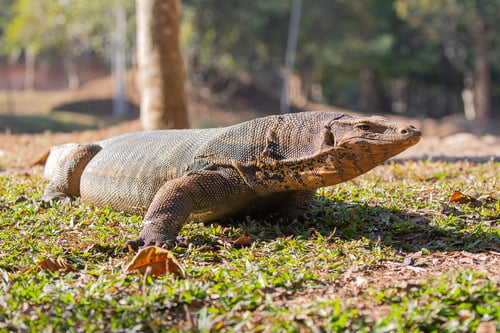Andaman Water Monitor

Andaman Water Monitor (Varanus salvator Andamanensis). The attractive reptile species known as the Andaman Water Monitor, or Varanus salvator Andamanensis, is found in the Andaman and Nicobar Islands. This lizard, a member of the Varanidae family and a subspecies of the Southeast Asian water monitor makes a fascinating investigation subject. Also examine this creature’s taxonomy, distribution, population biology, state of conservation, and challenges it faces in this blog in order to offer light on its unique features and habitat preferences.
The attractive reptile species known as the Andaman Water Monitor, or Varanus salvator Andamanensis, is found in the Andaman and Nicobar Islands. This lizard, a member of the Varanidae family and a subspecies of the Southeast Asian water monitor makes a fascinating investigation subject. Also examine this creature’s taxonomy, distribution, population biology, state of conservation, and challenges it faces in this blog in order to offer light on its unique features and habitat preferences.
Description and Taxonomy
The Andaman Water Monitor is a species of the Squamata order and belongs to the Chordata phylum and Animalia kingdom. It specifically belongs to the Varanidae family, the Sauria suborder, and the Varanus genus. The dorsal backdrop of this lizard is a unique uniform black colour with transverse rows of tiny spots, called ocelli. Its body and limbs are decorated with sporadic groupings of yellowish dots and spots, while its tail features rows of light spots and dots. The Andaman Water Monitor is visually arresting and distinctive due to the vivid floral patterns of yellow spots on its dorsum. India, Sri Lanka, Bangladesh, Myanmar, Cambodia, Laos, Vietnam, China, Thailand, Malaysia, Singapore, and Indonesia are all included in its dispersion.
Distribution and Habitat
The southern Nicobar Islands and the Andaman Islands, which are both geographically part of the Republic of India, are ideal habitats for the Andaman Water Monitor. Photographic evidence and investigation of museum specimens have been used to confirm their existence in these areas. This species demonstrates exceptional versatility, living happily in a variety of natural settings, including mangrove swamps and primary forests. Its intriguing population biology is a result of its widespread distribution and capacity to flourish in a variety of situations.
Biology of the Population and the State of Conservation
The Andaman Water Monitor is seen as bountiful in many places, especially urban regions like Bangkok, despite the lack of precise population numbers. However, hunting poses serious challenges to this species. Its meat is eaten, and its fat is utilized in conventional medicine. Its skin is highly prized in the leather industry. The population in some areas has decreased as a result of these activities, prompting conservation efforts.
On the IUCN Red List, the Andaman Water Monitor currently has the conservation classification of Least Concern. Although this classification indicates a largely stable population, it is essential to monitor and control hunting activities to guarantee the long-term survival of the species. Legislative actions, like its listing in Appendix II of CITES, are intended to control international commerce and safeguard the Andaman Water Monitor from overuse.
Threats and efforts for conservation
There are many risks to the Andaman Water Monitor, most of which are caused by human activity. The enormous demand for its skin in the leather industry puts the species at grave risk. These lizards are hunted for their expensive skins, which are used to make belts, fashion accessories, and other leather goods. Furthermore, the Andaman Water Monitor’s meat is eaten in some areas, and its fat is employed in traditional medicine. These actions have endangered the species and caused a reduction in population size.
Conservation activities are essential to combat these dangers and guarantee the Andaman Water Monitor’s long-term survival. It is crucial that tight rules be put in place and that laws against the hunting and selling of this species be upheld. The Andaman Water Monitor’s protection may also be aided by raising awareness of its ecological importance among stakeholders, visitors, and local residents.
The Andaman Water Monitor is actively being monitored and protected by government organizations and conservation groups. To learn more about the population size, distribution, and habitat needs of the species, researchers perform studies. Such knowledge is useful in creating management and conservation methods that are effective.
Programs for education and outreach are essential in spreading the word about the value of protecting the Andaman Water Monitor and its natural environment. These programs seek to involve local residents, students, and visitors in activities that support environmental protection and ethical travel. It is possible to encourage a sense of stewardship among all stakeholders by emphasizing the financial and ecological advantages of protecting this species.
Furthermore, habitat protection is essential for the survival of the Andaman Water Monitor. By preserving the main forests and mangrove swamps that are their native habitats, we can guarantee that there will always be places where they can nest and eat. These lizards and other related species can find refuge by being protected and by having habitat restoration programs put in place.
Summary
Hunting and habitat destruction pose serious risks to the Andaman Water Monitor, Varanus salvator Andamanensis. However, there is hope for the long-term survival of this unusual reptile thanks to cooperative efforts by conservation organizations, governmental organizations, local communities, and responsible tourists. We can secure the future of the Andaman Water Monitor by enacting stronger hunting laws, increasing awareness, and maintaining their natural habitats. Let’s take on the duty of safeguarding this intriguing species and making sure it survives in balance with its environment for future generations.